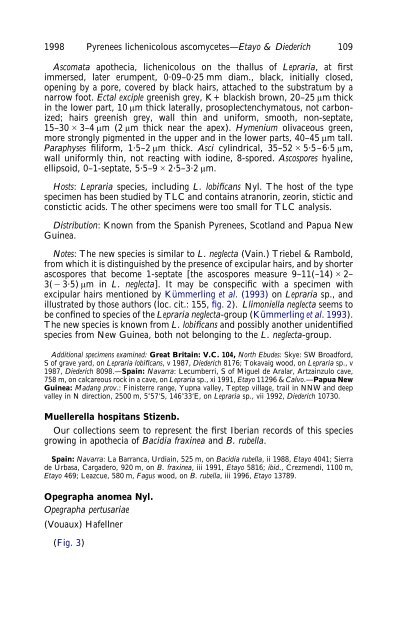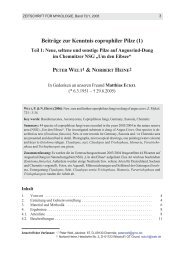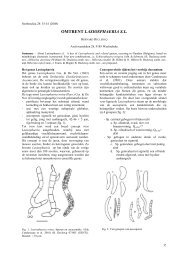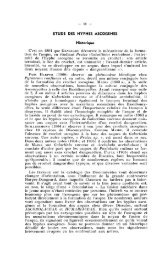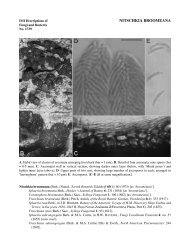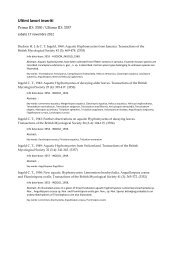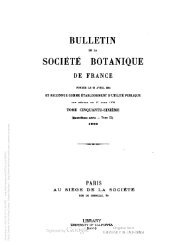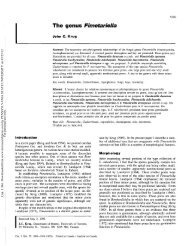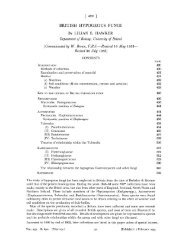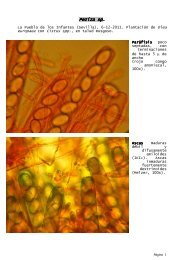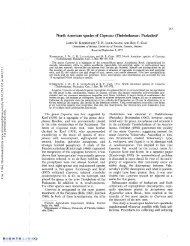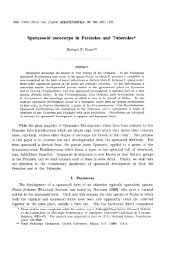LICHENICOLOUS FUNGI FROM THE WESTERN PYRENEES, FRANCE AND SPAIN ...
LICHENICOLOUS FUNGI FROM THE WESTERN PYRENEES, FRANCE AND SPAIN ...
LICHENICOLOUS FUNGI FROM THE WESTERN PYRENEES, FRANCE AND SPAIN ...
Create successful ePaper yourself
Turn your PDF publications into a flip-book with our unique Google optimized e-Paper software.
1998 Pyrenees lichenicolous ascomycetes—Etayo & Diederich 109<br />
Ascomata apothecia, lichenicolous on the thallus of Lepraria, at first<br />
immersed, later erumpent, 0·09–0·25 mm diam., black, initially closed,<br />
opening by a pore, covered by black hairs, attached to the substratum by a<br />
narrow foot. Ectal exciple greenish grey, K+ blackish brown, 20–25 m thick<br />
in the lower part, 10 m thick laterally, prosoplectenchymatous, not carbonized;<br />
hairs greenish grey, wall thin and uniform, smooth, non-septate,<br />
15–303–4 m (2m thick near the apex). Hymenium olivaceous green,<br />
more strongly pigmented in the upper and in the lower parts, 40–45 m tall.<br />
Paraphyses filiform, 1·5–2 m thick. Asci cylindrical, 35–525·5–6·5 m,<br />
wall uniformly thin, not reacting with iodine, 8-spored. Ascospores hyaline,<br />
ellipsoid, 0–1-septate, 5·5–92·5–3·2 m.<br />
Hosts: Lepraria species, including L. lobificans Nyl. The host of the type<br />
specimen has been studied by TLC and contains atranorin, zeorin, stictic and<br />
constictic acids. The other specimens were too small for TLC analysis.<br />
Distribution: Known from the Spanish Pyrenees, Scotland and Papua New<br />
Guinea.<br />
Notes: The new species is similar to L. neglecta (Vain.) Triebel & Rambold,<br />
from which it is distinguished by the presence of excipular hairs, and by shorter<br />
ascospores that become 1-septate [the ascospores measure 9–11(–14)2–<br />
3(3·5) m in L. neglecta]. It may be conspecific with a specimen with<br />
excipular hairs mentioned by Kümmerling et al. (1993) on Lepraria sp., and<br />
illustrated by those authors (loc. cit.: 155, fig. 2). Llimoniella neglecta seems to<br />
be confined to species of the Lepraria neglecta-group (Kümmerling et al. 1993).<br />
The new species is known from L. lobificans and possibly another unidentified<br />
species from New Guinea, both not belonging to the L. neglecta-group.<br />
Additional specimens examined: Great Britain: V.C. 104, North Ebudes: Skye: SW Broadford,<br />
S of grave yard, on Lepraria lobificans, v 1987, Diederich 8176; Tokavaig wood, on Lepraria sp., v<br />
1987, Diederich 8098.—Spain: Navarra: Lecumberri, S of Miguel de Aralar, Artzainzulo cave,<br />
758 m, on calcareous rock in a cave, on Lepraria sp., xi 1991, Etayo 11296 & Calvo.—Papua New<br />
Guinea: Madang prov.: Finisterre range, Yupna valley, Teptep village, trail in NNW and deep<br />
valley in N direction, 2500 m, 557S, 14633E, on Lepraria sp., vii 1992, Diederich 10730.<br />
Muellerella hospitans Stizenb.<br />
Our collections seem to represent the first Iberian records of this species<br />
growing in apothecia of Bacidia fraxinea and B. rubella.<br />
Spain: Navarra: La Barranca, Urdiain, 525 m, on Bacidia rubella, ii 1988, Etayo 4041; Sierra<br />
de Urbasa, Cargadero, 920 m, on B. fraxinea, iii 1991, Etayo 5816; ibid., Crezmendi, 1100 m,<br />
Etayo 469; Leazcue, 580 m, Fagus wood, on B. rubella, iii 1996, Etayo 13789.<br />
Opegrapha anomea Nyl.<br />
Opegrapha pertusariae<br />
(Vouaux) Hafellner<br />
(Fig. 3)


